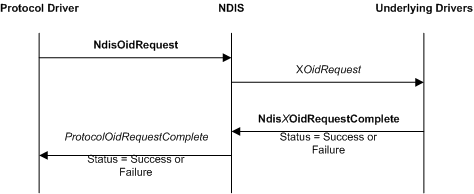Generating OID Requests from an NDIS Protocol Driver
To originate an OID request to underlying drivers, a protocol calls the NdisOidRequest function.
The following figure illustrates an OID request that is originated by a protocol driver.

After a protocol driver calls the NdisOidRequest function, NDIS calls the request function of the next underlying driver. For more information about how a miniport driver handles OID requests, see OID Requests for an Adapter. For more information about how a filter driver handles OID requests, see Filter Module OID Requests.
To complete synchronously, NdisOidRequest returns NDIS_STATUS_SUCCESS or an error status. To complete asynchronously, NdisOidRequest returns NDIS_STATUS_PENDING.
If NdisOidRequest returns NDIS_STATUS_PENDING, NDIS calls the ProtocolOidRequestComplete function after the underlying drivers complete the OID request. In this case, NDIS passes the results of the request at the OidRequest parameter of ProtocolOidRequestComplete. NDIS passes the final status of the request at the Status parameter of ProtocolOidRequestComplete.
If NdisOidRequest returns NDIS_STATUS_SUCCESS, it returns the results of a query request in the NDIS_OID_REQUEST structure at the OidRequest parameter. In this case, NDIS does not call the ProtocolOidRequestComplete function.
To determine what information was successfully handled by an underlying driver, protocol drivers that issue OID requests must check the value in the SupportedRevision member in the NDIS_OID_REQUEST structure after the OID request returns. For more information about NDIS version information, see Specifying NDIS Version Information.
If the underlying driver should associate the OID request with a subsequent status indication, the protocol driver should set the RequestId member in the NDIS_OID_REQUEST structure. When the underlying driver makes a status indication, it sets the RequestId member in the NDIS_STATUS_INDICATION structure to the value that is provided in the OID request.
A driver can call NdisOidRequest when a binding is in the Restarting, Running, Pausing, or Paused state.